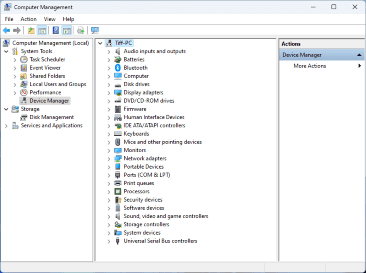Microsoft Management Console (MMC) is a component of Windows 2000 and its successors that provides system administrators and advanced users an interface for configuring and monitoring the system.
Snap-ins and consoles
The management console can host Component Object Model components called snap-ins. Most of Microsoft's administration tools are implemented as MMC snap-ins. Third parties can also implement their own snap-ins using the MMC's application programming interfaces published on the Microsoft Developer Network's web site.
Snap-ins are registered in the [HKEY_CLASSES_ROOT]{CLSID} and [HKEY_LOCAL_MACHINESoftwareMicrosoftMMCSnapins] registry keys. A snap-in combined with MMC is called a management saved console, which is a file with .msc extension and can be launched using this syntax: mmc path filename.msc [/a] [/64] [/32].
The most prolific MMC component, Computer Management, appears in the "Administrative Tools" folder in the Control Panel, under "System and Security" in Category View. Computer Management actually consists of a collection of MMC snap-ins, including the Device Manager, Disk Defragmenter, Internet Information Services (if installed), Disk Management, Event Viewer, Local Users and Groups (except in the home editions of Windows), Shared Folders, and other tools. Computer Management can also be pointed at another Windows machine altogether, allowing for monitoring and configuration of other computers on the local network that the user has access to.
Other MMC snap-ins in common use include:
Microsoft Exchange ServerActive Directory Users and Computers, Domains and Trusts, and Sites and ServicesGroup Policy Management, including the Local Security Policy snap-in included on all Windows 2000 and later systems (Home editions of Microsoft Windows disable this snap-in)Services snap-in, for managing Windows servicesPerformance snap-in, for monitoring system performance and metricsEvent Viewer, for monitoring system and application eventsMMC 1.0, shipped with Windows NT 4.0 Option Pack.MMC 1.1, shipped with SQL Server 7.0 and Systems Management Server 2.0, and also made available as a download for Windows 9x versions and Windows NT. New features:Snap-in taskpadsWizard-style property sheetsAbility to load extensions to a snap-in at run-timeHTML Help supportMMC 1.2, shipped with Windows 2000. New features:Support for Windows Installer and Group PolicyFiltered viewsExporting list views to a text filePersistence of user-set column layouts (i.e. widths, ordering, visibility and sorting of lists)MMC 2.0, shipped with Windows XP and Windows Server 2003. New features:Operating system-defined visual stylesAutomation object model, allowing the capabilities of an MMC snap-in to be used programmatically from outside MMC itself (e.g. from a script)64-bit snap-insConsole TaskpadsView ExtensionsMultilanguage User Interface help filesMMC 3.0, shipped with Windows Server 2003 SP2, Windows XP SP3 and subsequent versions of Windows. Also downloadable for Windows XP SP2 and Windows Server 2003 SP1. New features:A new "Actions pane", displayed on the right-hand side of the MMC user interface that displays available actions for currently-selected nodeSupport for developing snap-ins with the .NET framework, including Windows FormsReduced amount of code required to create a snap-inImproved debugging capabilitiesAsynchronous user interface model (MMC 3.0 snap-ins only)True Color Icon Support (Windows Vista Only)New Add/Remove Snap-in UIDEP is always enforced. All snap-ins must be DEP-aware.
